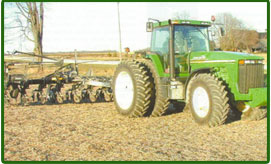
 be the preferred full-width conservation tillage alternative on these soils.
Indeed, fall disking has proven to give higher corn yields than most other fall
tillage options in experiments on soils with high silt and/or clay contents.
be the preferred full-width conservation tillage alternative on these soils.
Indeed, fall disking has proven to give higher corn yields than most other fall
tillage options in experiments on soils with high silt and/or clay contents.
Farmer dissatisfaction with spring seedbed conditions and corn performance after chisel plowing on soils with high clay and/or silt contents has resulted in the continued use of the moldboard plow on many farms, in some cases even following soybeans. This has resulted in significant soil erosion on many Ontario farms, particularly during the past two springs which recieved abnormally high rainfall amounts. For those farmers reluctant to adopt zone tillage at present, disking is worth considering as an intermediate tillage option on these heavier soils.
Table 1 summarizes results from tillage experiments which included fall disking over the past 18 years in south-western Ontario. Tillage systems common to each of these trials were: 1) fall moldboard, 2) fall chisel with 4" twisted-shovel teeth, 3) fall disk and 4) no-till. The fall disk system consisted of either offset (one-way) disking 5" deep with spring secondary tillage or tandem disking 3 to 4" deep with no spring secondary tillage.
Following soybeans, no-till corn yields were within 5 bu/ac of moldboard plowing at three locations, indicating that there was little economic benefit to conducting fall tillage. However, at the other two locations tillage substantially increased yields. Fall disking often resulted in yields which were similar to, or greater than, those obtained after moldboard plowing.
Regardless of the previous crop, grain corn yields with fall disking were greater than, or at least similar to, those obtained after fall chisel plowing. Even where fall disking occurred without secondary tillage, yields were often greater than fall chisel plowing with secondary tillage. At many of the locations, the main reason for higher yields after fall disking was that there was less year-to-year variability in yields compared to either the chisel or no-till systems.
A concern commonly expressed about disking is soil compaction. We agree that spring disking in fields that are too wet can result in serious soil compaction and that modern discs generally have more weight per blade. However, evidence of significant soil compaction associated with fall disking have not been observed on any of our trials. In fact, soil measurements after 11 consecutive years of fall offset disking near Elora could not identify any differences (compared to moldboard and chisel plowing) in soil compactness within, as well as below, the depth of tillage.
Another concern of producers, on poorly or inadequately drained silt loam and clay textured soils is the rate of soil drying in early spring. In our research, fall disking these soils was often as effective as either fall moldboard or chisel plowing in enhancing spring soil dry-down rates. Also, since disks leave soils fairly level, the risk of excessive drying of soils during early dry springs is reduced, particularly when compared to rough (ridged) chisel plowed fields.
Fall disking generally provides more opportunity to minimize secondary tillage to a single pass (if required at all). Multiple passes of relatively deep secondary tillage in plowed fields are often required to level fields, not to improve seedbed fineness. Excessive secondary tillage not only increases costs, it increases the risk of soil erosion and crusting as well.
In conclusion, fall disking has generally resulted in ideally aggregated seedbeds with favourable early spring moisture conditions for maximizing corn yields. Also, especially after corn and cereals, fall disking can leave sufficient residue cover to significantly reduce erosion risk. Single pass fall disking can be expected to result in more consistent, and often higher, corn yields than some chisel plow systems on silt loam and clay textured soils.
Table
1.Average grain corn yield response to tillage from trials conducted
following various previous crops (1979-1996). |
|||||||
|
Location |
Soil |
Previous |
#
of |
Tillage System |
|||
|
Moldboard |
Chisel |
Disk |
No-till ¶ |
||||
|
Milton |
Clay loam |
Corn |
2 |
117 |
109 |
109 |
103 |
|
Elora |
Silt Loam |
Corn |
7 |
123 |
117 |
121 |
106 |
|
Elora |
Silt Loam |
Soys |
2 |
118 |
118 |
124 |
104 |
|
Comber* |
Clay Loam |
Soys |
3 |
124 |
117 |
124 |
119 |
|
Morpeth* |
Clay |
Soys |
2 |
108 |
98 |
110 |
103 |
|
Alvinston |
Clay |
Soys |
3 |
95 |
86 |
91* |
85 |
|
Fingal |
Silty clay loam |
Soys |
3 |
159 |
154 |
154* |
154 |
|
Centralia |
Silt loam |
Wheat baled |
3 |
146 |
139 |
141* |
135 |
|
Wyoming |
Silty clay loam |
Wheat baled |
3 |
159 |
155 |
157* |
149 |
| ¶
Where corn was planted no-till, or after fall disking without secondary
tillage, the corn planter was equipped with a single 1" fluted coulter
positioned in front, unit-mounted, spoke-trash wheels, and a fertilizer
coulter 2" to the side of each row *Tillage consisted of only fall tandem disking without secondary tillage. Otherwise, the disk treatment consisted of fall offset disking with secondary tillage. - Data courtesy of D. Young (RCAT) |
|||||||